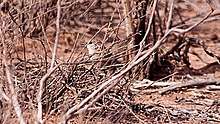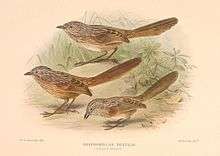Thick-billed grasswren
The thick-billed grasswren (Amytornis modestus) is a species of bird in the family Maluridae. It is endemic to Australia. Its natural habitat is Mediterranean-type shrubby vegetation.
| Thick-billed grasswren | |
|---|---|
 | |
| Scientific classification | |
| Kingdom: | Animalia |
| Phylum: | Chordata |
| Class: | Aves |
| Order: | Passeriformes |
| Family: | Maluridae |
| Genus: | Amytornis |
| Species: | A. modestus |
| Binomial name | |
| Amytornis modestus (North, 1902) | |
| Subspecies | |
|
See text | |
| Synonyms | |
| |
Taxonomy and systematics
The thick-billed grasswren was formerly considered as conspecific with the western grasswren until split as a separate species in 2010.[2]
Subspecies
While not completely accepted by all authourities, the following seven subspecies are recognized by Clements and the IOC:[3]
- †A. m. modestus – (North, 1902): Now extinct. Formerly found in Northern Territory (central Australia)
- A. m. indulkanna – (Mathews, 1916): Found in Northern Territory and South Australia (central Australia)
- A. m. raglessi – Black, 2011: Found in Flinders Ranges in South Australia (central Australia)
- A. m. curnamona – Black, 2011: Found in Lake Frome Basin in South Australia (central Australia)
- A. m. cowarie – Black, 2016: Found in Sturt Stony Desert in South Australia (central Australia)
- A. m. obscurior – (Mathews, 1923): Found in New South Wales (central Australia)
- †A. m. inexpectatus – (Mathews, 1912): Now extinct. Formerly found in New South Wales (central Australia)
Description

The thick-billed grasswren has dull brown underparts, a long dark-brown tail and noticeable white streaking on the head. It has white streaks continuing down the neck, throat and down to the rump. The white streaks across the chin to the forehead and along the wings and rump, contrast with the red-brown to grey colours of the feathers. Males have distinguishably longer tails. Females also have chestnut flanks. Vocals are a combination of short high-pitched song, repeated. They have a soft, high-pitched call that is often inaudible to human ears.
Distribution and habitat
The thick-billed grasswren is endemic to Australia and is found throughout the arid regions of northwestern New South Wales (NSW), northern parts of South Australia, through to southern sections of the Northern Territory.[4][5] It is also speculated to still occur in fragmented populations in the Grey Range of Sturt National Park.
Chenopod scrublands (consisting largely of saltbush), sandhill cane-grass and flood debris in dry, sandy watercourses. They favour the scrublands with dense chenopod bushes. These denser shrublands usually occur in lower lying areas, such as watercourses and drainage lines. Both subspecies, occurring at different distributions prefer particular species. The Eastern Thick-billed Grasswren prefers saltbush. The Western Thick-billed Grasswren; black-bush and Australian boxthorn.
Behaviour and ecology
Thick-billed grasswrens are usually sedentary, with these elusive birds seen running, hopping or rarely flying, between vegetative cover to remain undetected. They can also be seen foraging for food at ground level around vegetation. Wrens have a generalist beak type that allows them to eat a range of foods. The thick bill allows for tougher seeds and other food niches to be accessed, compared with the smaller fairy wren species. If disturbed, individuals take refuge in any existing cover – usually vegetation or piles of old flood debris along dry sandy watercourses and even down rabbit burrows. They are often seen solitarily or in pairs. Sources vary, but mating pairs maintain between five, and 20 to 40 hectare territories year-round and rarely, possibly never, band with their neighbours outside the breeding season. Family groups are sometimes seen during the post-fledgling period, while the young are still dependent on their parents.[6] The feather patterns/markings imitate their preferred habitat as a form of camouflage.
Breeding
Breeding occurs between July and September. Nests can usually be seen in low branches in saltbush, can-grass and other similar vegetation. The nest composes of loose grass and bark in the shape of a half dome, with finer grass, fur, feathers lining the nest. One to three (usually two) eggs of various colourings of white, cream and pink; with blotches of red-brown or purplish grey. They have an incubation period of two weeks and fledge in 10–12 days. The estimated generation length of the thick-billed grasswren is four years .
Feeding
The thick-billed grasswren eats mainly insects and other small invertebrates, as well as plant seeds and berries.
Threats
The main threat to thick-billed grasswrens is loss of habitat through clearing and overgrazing by hard hooved animals, such as sheep and goats that trample the vegetation. This reduces the area and quality of the habitat that the thick-billed grasswren prefer. Particularly the larger shrubs that provide prime habitat for breeding. Habitat modification has also occurred due to rabbits. Feral species, such as foxes and cats are major threats due to predation. All threats have been compounded by droughts over the past decade.
High frequency wildfires are also a threat to the quality of habitat. Higher frequency of fires disrupts the life cycle processes of the thick-billed grasswren, as well as the plants and macroinvertebrates that they depend on. Changes in expected environmental conditions, will also challenge tolerance ranges and exacerbate the impacts of existing threats to the species.
Status
The thick-billed grasswren is a poor flyer, and because of this has a poor dispersal capability and is highly susceptible to population fragmentation. Both the NSW Government Office of Environment and Heritage, and the Commonwealth of Australia, classify the thick-billed grasswren as critically endangered. However the South Australian government and the IUCN red list classify the thick-billed grass wren as ‘least concern’. It was gazetted under the Environmental Protection and Biodiversity Conservation (EPBC) Act 1999, in 2009.
References
- BirdLife International (2009). "Amytornis textilis". IUCN Red List of Threatened Species. 2009. Retrieved 21 February 2012.CS1 maint: ref=harv (link)
- "Species Version 2 « IOC World Bird List". www.worldbirdnames.org. Retrieved 2017-07-25.
- IOC v.6.3
- "Amytornis modestus — Thick-billed Grasswren (eastern)". Department of Sustainability, Environment, Water, Population and Communities. Australian Government. Retrieved 21 February 2012.
- Black, Andrew; Carpenter, Graham; Pedler, Lynn (September 2011). "Distribution and habitats of the Thick-billed Grasswren Amytornis modestus and comparison with the Western Grasswren Amytornis textilis myall in South Australia" (PDF). South Australian Ornithologist. 37 (2): 60–80. Retrieved 9 October 2015.
- Energy, Department of the Environment and (2013-07-04). "Thick-billed Grasswren (Eastern Subspecies) (Amytornis textilis modestus) (North, 1902) Recovery Plan". www.environment.gov.au. Retrieved 2017-07-25.
Barrett, G.W., Silcocks, A.F., Cunningham, R., Oliver, D.L., Weston, M.A. & Baker, J. (2007). Comparison of atlas data to determine the conservation status of bird species in New South Wales, with an emphasis on woodland-dependent species. Australian Zoologist 34, 37–77.
Cayley, N. W., Chisholm, A. H., Hindwood, K., McGill, A. R., Roberts, P., & Lindsey, T. (1991). What bird is that? Angus & Robertson: Australia.
Garnett, S. & Crowley, G. (Eds) (2000). ‘The Action Plan for Australian Birds 2000’. (Environment Australia: Canberra).
Government of South Australia, South Australian Arid Lands Natural Resource Management Board (2011). Fact sheet: thick-billed grasswrens. Retrieved from www.saalnrm.sa.gov.au
Higgins, P.J., Peter, J.M. & Steele WK (Eds) (2001). ‘Handbook of Australian, New Zealand and Antarctic Birds’, vol. 5. (Oxford University Press: Melbourne).
McAllan, IAW (1987). Early records of the Thick-billed Grasswren Amytornis textilis and Striated Grasswren Amytornis striatus. Australian Birds 21, 33–34.
McAllan, IAW (2000). On some New South Wales records of the Grey Grasswren and the Thickbilled Grasswren. Australian Bird Watcher 18, 244–246. NPWS (2002). Thick-billed Grasswren (eastern subspecies) Amytornis textilis modestus (North, 1902) Recovery Plan. NSW National Parks and Wildlife Service, Hurstville NSW.
Office of Environment and Heritage (2016). Thick-billed Grasswren (eastern subspecies) – profile. Retrieved from http://www.environment.nsw.gov.au/threatenedspeciesapp/profile.aspx?id=10049
Pizzey, G., & Knight, F. (2012). The field guide to the birds of Australia. Harper Collins Publishers: Australia.
